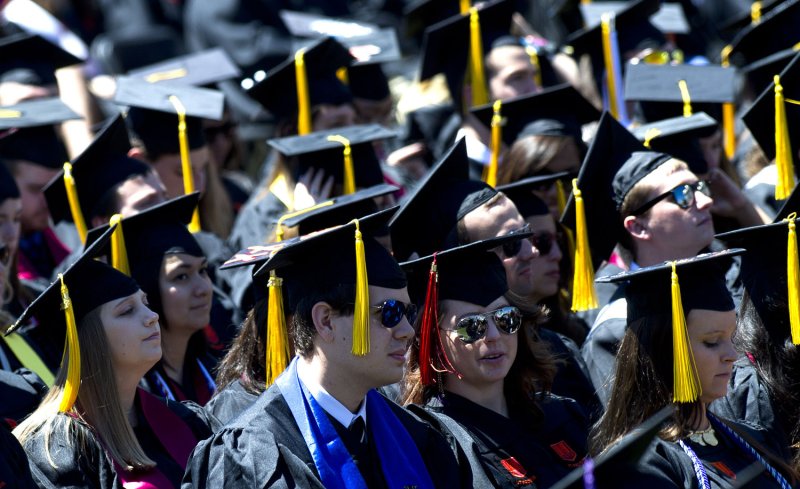Graduates participate in the 2012 Virginia Tech graduation ceremony at Lane Stadium on the campus of Virginia Tech University in Blacksburg, Virginia on May 11, 2012. UPI/Kevin Dietsch |
License Photo
Parents don't need an army of economists to tell them college is too expensive and too many students will default on their education loans.
An economy that creates too few well-paid jobs is part of the problem, but colleges and universities are spending foolishly and not providing the kind of education students need to compete.
Eighty percent of students attend public colleges and universities, and at most, inflation-adjusted spending per student has hardly changed over the last 25 years.
As mandatory state contributions to Medicaid and funding for K-12 education have increased, public subsidies for higher education have been curtailed. Parents through higher tuition and students through bigger loans have been forced to shoulder a greater share of the cost.
Meanwhile, colleges and universities increasingly compete for students by shifting resources from educational purposes into athletic arenas, lavish student centers and other frivolous amenities, euphemistically justified as building community and enhancing the student experience.
Faculty measure their success by how little they teach, and many disparage instruction in anything remotely useful in the job market.
University presidents manage to provide students with the entertainment they demand and faculty the lifestyles they desire by encouraging enrollment in the lower cost, but not particularly practical programs, such as art history and global studies, while limiting access to more-expensive schools of business, engineering and the like.
Too many graduates end up selling cell phones or working at Starbucks.
President Obama proposes to rate colleges on metrics such as tuition, graduation rates, debt and earnings of graduates, and the percentage of low income students enrolled, and limit access to federal loans for students at institutions that do poorly.
Much of this would make matters worse.
Compelling elite institutions, which already offer scholarships to qualified disadvantaged students, to enroll additional low income students would put the latter into competitive environments they cannot handle. Their prospects for completing a degree and paying off their debt would be less than if they enrolled at a middle-range state college.
Consider how arbitrary it would be to compare starting salaries for graduates from Boston's elite Berklee College of Music with New York's Cooper Union schools of engineering.
The whole regulatory process would become political and subject to abuse, but lobbying and gaming bureaucracies are what university presidents and faculty do best.
Many historically black state colleges would lose applicants to elite institutions and be among the most vulnerable to losing federal aid, an outcome liberals would not tolerate.
In the end, the only institutions not receiving high enough ratings to maintain full access to federal loans would be private proprietary colleges -- institutions that mainstream academics absolutely loath.
A better solution would be to compel colleges and universities to be more careful about the programs they offer and how much money their students borrow. For example, deny access to federal student loans to institutions with more than 10 percent of their former students behind in payments, or 20 percent of their students failing to pay off their debts within 15 years of first enrollment.
Reasonable extensions could be provided for students that go on to professional or other graduate training, but colleges would face strong incentives to perform better.
University presidents would be compelled to ensure art history and peace studies programs did not enroll more students than could find some reasonable purposes for their degrees and devote more resources to curriculum with solid career outcomes.
University presidents would be compelled by competition in the job market for new graduates to spend less on football and yoga classes and more on career focused curriculum.
University presidents would find all this would become more manageable if they trimmed staff and used facilities more efficiently, and hence were able to lower tuition and permit students to borrow less.
And horrors, faculty would have to teach more and pay more attention to making useful what they teach.
Peter Morici is an economist and professor at the Smith School of Business, University of Maryland, and a national columnist.















